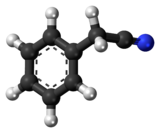
| |

| |
| Names | |
|---|---|
| Preferred IUPAC name
Phenylacetonitrile[1] | |
| Other names | |
| Identifiers | |
3D model (JSmol)
|
|
| ChEBI | |
| ChemSpider | |
| ECHA InfoCard | 100.004.919 |
| KEGG | |
PubChem CID
|
|
| UNII | |
CompTox Dashboard (EPA)
|
|
| |
| |
| Properties | |
| C8H7N | |
| Molar mass | 117.15 g/mol |
| Appearance | Colorless oily liquid |
| Density | 1.015 g/cm3 |
| Melting point | −24 °C (−11 °F; 249 K) |
| Boiling point | 233 to 234 °C (451 to 453 °F; 506 to 507 K) |
| -76.87·10−6 cm3/mol | |
Except where otherwise noted, data are given for materials in their standard state (at 25 °C [77 °F], 100 kPa).
| |
Benzyl cyanide (abbreviated BnCN) is an organic compound with the chemical formula C6H5CH2CN. This colorless oily aromatic liquid is an important precursor to numerous compounds in organic chemistry.[2] It is also an important pheromone in certain species.[3]
- ^ a b Nomenclature of Organic Chemistry : IUPAC Recommendations and Preferred Names 2013 (Blue Book). Cambridge: The Royal Society of Chemistry. 2014. p. 16. doi:10.1039/9781849733069-FP001. ISBN 978-0-85404-182-4.
- ^ Pollak, Peter; Romeder, Gérard; Hagedorn, Ferdinand; Gelbke, Heinz-Peter (2000). "Nitriles". Ullmann's Encyclopedia of Industrial Chemistry. doi:10.1002/14356007.a17_363. ISBN 3527306730.
- ^ https://www.mpg.de/20278575/0504-choe-chemisches-signal-schuetzt-wanderheuschrecken-vor-kannibalismus [bare URL]